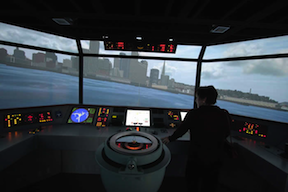Bridge Simulation
The Simulation Center houses a total of 11 full-mission simulators with different specifications and purposes. Two simulators have a visual view of 360 degrees. One simulator has a visual view of 225 degrees. The bridge equipment for each of these bridges consists of the main console, steering stand and gyro compass repeater for acquiring visual bearings. On the main console is the electronic vessel conning station, Radar/ARPA, and ECDIS/AIS. Also on the main console are the vessel alarms, monitoring and control systems. The bridge is equipped with the Transas Marine GMDSS station which provides Satellite, HF, MF and VHF communications.

The training configuring of all bridges is very versatile. For example, in one configuration each bridge can be operated independently in different geographic areas. In another, each bridge can be operated as distinct and separate vessels in the same exercise area (joint exercises). Finally, all bridges can be configured as the same vessel in the exercise area. This last training configuration is very useful when comparing outcomes of different bridge teams for the same exercise. The bridges are also unique in that vessel analog controllers can be swapped out on all bridges to conform to Bridge Ownship requirements. At present we have conventional propulsion vessels with either single or twin propellers, and vessels with Azipod propulsion, Voith-Schneider propulsion, Z-drive propulsion, and flanking rudders controllers. Vessels in the same exercise can interact with one another (i.e., a bridge configured as a tug can assist a bridge configured as a ship in a docking exercise).
The final eight bridges all have a 60-degree view. The bridges all have the electronic vessel conning station, Radar/ARPA, and ECDIS/AIS. These bridges are mainly used for part-task training but can be fully integrated with the other three bridges for exercise.
These simulators are used not only by academy cadets for experiential training, but they also are used to upgrade the skills of industry mariners as well as for conducting research in ship handling, accident investigation, port development, simulation pedagogy, and human factors.
Why Cal Maritime?
- Top Instructors
- Innovative Curriculum
- Unparalleled Facilities
- Complete Student Satisfaction